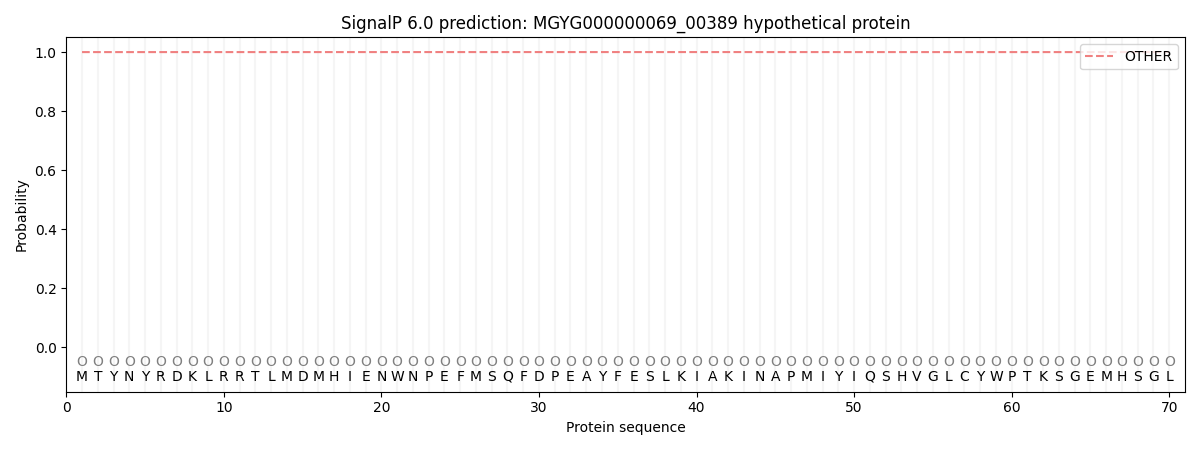You are browsing environment: HUMAN GUT
CAZyme Information: MGYG000000069_00389
You are here: Home > Sequence: MGYG000000069_00389
Basic Information |
Genomic context |
Full Sequence |
Enzyme annotations |
CAZy signature domains |
CDD domains |
CAZyme hits |
PDB hits |
Swiss-Prot hits |
SignalP and Lipop annotations |
TMHMM annotations
Basic Information help
| Species | Clostridium_A leptum | |||||||||||
|---|---|---|---|---|---|---|---|---|---|---|---|---|
| Lineage | Bacteria; Firmicutes_A; Clostridia; Oscillospirales; Acutalibacteraceae; Clostridium_A; Clostridium_A leptum | |||||||||||
| CAZyme ID | MGYG000000069_00389 | |||||||||||
| CAZy Family | GH151 | |||||||||||
| CAZyme Description | hypothetical protein | |||||||||||
| CAZyme Property |
|
|||||||||||
| Genome Property |
|
|||||||||||
| Gene Location | Start: 414887; End: 417004 Strand: - | |||||||||||
Full Sequence Download help
| MTYNYRDKLR RTLMDMHIEN WNPEFMSQFD PEAYFESLKI AKINAPMIYI QSHVGLCYWP | 60 |
| TKSGEMHSGL IGKEDAMKRL FDLCHDDGMA VVAYYSIIYN NWAYHEHPEW QMRDLEGRGS | 120 |
| RATGKRYGLC CPNNMEYRDF IRTQMAEFCD YFDFEGIFLD MTFWPMVCYC DECRARWEKE | 180 |
| VGGPMPKVID WKDDRWNLFQ RKRQEWMEDF ALDMTVEIKK HKPECAVEHQ YSNAVHMWNR | 240 |
| GVNENIAKAS DYAGGDLYGG IAQQSFACKL YYNLTQIQPF EYMTSRCYPA LSEHTTTKSM | 300 |
| DQLRASILVT ALHHGASLMI DAIDPKGTHD RRVYEAIGQV HGEMEHYEKY LTRGEMAYDV | 360 |
| GVYFNLNGKM DVENNGVKIG SKEETDDTMP HLDASIGAGK SLQRHHIPYT VLNNWKLELL | 420 |
| KDTKVVVLAD APMISEKERD ALRKYVKDGG RLYMSGHSAP ELAEEFFGGT IEGLTQEDIT | 480 |
| YISPAEGTDW MQGYFTKDYP LVMFERSFKM KGQKNGEVLG TLTLPYTVPN PLGIFTDLCS | 540 |
| YASEIVTKDD PRYPFATIHA NPPGIFTDYP AVLKTQYGKG TVIWSCVPFE KAERFQHSDI | 600 |
| FSGLIRSLLS EEPVFSSSTA PEPVEFVVFD APEYKEKYIG MVNLQEDFRF LPVYHFDVEI | 660 |
| KSPEKPVKVL KSYNDEPVAF TYENGKVKIS IDRLDCFDMY TLCYA | 705 |
CAZyme Signature Domains help
| Family | Start | End | Evalue | family coverage |
|---|---|---|---|---|
| GH151 | 30 | 161 | 4.7e-30 | 0.9923664122137404 |
CDD Domains download full data without filtering help
| Cdd ID | Domain | E-Value | qStart | qEnd | sStart | sEnd | Domain Description |
|---|---|---|---|---|---|---|---|
| pfam14871 | GHL6 | 1.37e-12 | 30 | 161 | 1 | 135 | Hypothetical glycosyl hydrolase 6. GHL6 is a family of hypothetical glycoside hydrolases. |
| cd14791 | GH36 | 6.52e-04 | 77 | 170 | 67 | 161 | glycosyl hydrolase family 36 (GH36). GH36 enzymes occur in prokaryotes, eukaryotes, and archaea with a wide range of hydrolytic activities, including alpha-galactosidase, alpha-N-acetylgalactosaminidase, stachyose synthase, and raffinose synthase. All GH36 enzymes cleave a terminal carbohydrate moiety from a substrate that varies considerably in size, depending on the enzyme, and may be either a starch or a glycoprotein. GH36 members are retaining enzymes that cleave their substrates via an acid/base-catalyzed, double-displacement mechanism involving a covalent glycosyl-enzyme intermediate. Two aspartic acid residues have been identified as the catalytic nucleophile and the acid/base, respectively. |
| cd03143 | A4_beta-galactosidase_middle_domain | 0.001 | 402 | 459 | 35 | 90 | A4 beta-galactosidase middle domain: a type 1 glutamine amidotransferase (GATase1)-like domain. A4 beta-galactosidase middle domain: a type 1 glutamine amidotransferase (GATase1)-like domain. This group includes proteins similar to beta-galactosidase from Thermus thermophilus. Beta-Galactosidase hydrolyzes the beta-1,4-D-galactosidic linkage of lactose, as well as those of related chromogens, o-nitrophenyl-beta-D-galactopyranoside (ONP-Gal) and 5-bromo-4-chloro-3-indolyl-beta-D-galactoside (X-gal). This A4 beta-galactosidase middle domain lacks the catalytic triad of typical GATase1 domains. The reactive Cys residue found in the sharp turn between a beta strand and an alpha helix termed the nucleophile elbow in typical GATase1 domains is not conserved in this group. |
| COG1874 | GanA | 0.001 | 5 | 283 | 9 | 311 | Beta-galactosidase GanA [Carbohydrate transport and metabolism]. |
| cd14745 | GH66 | 0.010 | 75 | 160 | 69 | 164 | Glycoside Hydrolase Family 66. Glycoside Hydrolase Family 66 contains proteins characterized as cycloisomaltooligosaccharide glucanotransferase (CITase) and dextranases from a variety of bacteria. CITase cyclizes part of a (1-6)-alpha-D-glucan (dextrans) chain by formation of a (1-6)-alpha-D-glucosidic bond. Dextranases catalyze the endohydrolysis of (1-6)-alpha-D-glucosidic linkages in dextran. Some members contain Carbohydrate Binding Module 35 (CBM35) domains, either C-terminal or inserted in the domain or both. |
CAZyme Hits help
| Hit ID | E-Value | Query Start | Query End | Hit Start | Hit End |
|---|---|---|---|---|---|
| BBH23071.1 | 7.22e-145 | 10 | 697 | 8 | 670 |
| QNK60153.1 | 1.42e-131 | 5 | 702 | 6 | 690 |
| BBD45930.1 | 5.74e-125 | 5 | 699 | 9 | 690 |
| AVM44410.1 | 5.22e-116 | 7 | 702 | 15 | 685 |
| BBH24081.1 | 3.93e-41 | 291 | 697 | 16 | 388 |
SignalP and Lipop Annotations help
This protein is predicted as OTHER

| Other | SP_Sec_SPI | LIPO_Sec_SPII | TAT_Tat_SPI | TATLIP_Sec_SPII | PILIN_Sec_SPIII |
|---|---|---|---|---|---|
| 1.000069 | 0.000000 | 0.000000 | 0.000000 | 0.000000 | 0.000000 |
